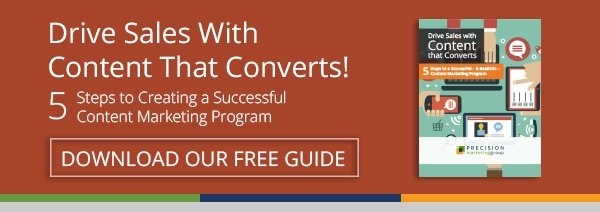Picture these two scenarios and decide with whom you would be more likely to do business...
- Business A attracts you with its quality content. The company engages you via chat with specific questions & answers on their website. The site also offers an on-demand tour of their product and gives you the option to schedule an appointment via an online scheduling tool on the spot and at your convenience.
- Business B also attracts you with its quality content. Once on the website, you get the same pop-up content offer on several pages. When you decide you want a demo, you complete a form, wait until the next day to be contacted, and have two more days of going back and forth before actually getting a meeting on the books.
While scenario B was once considered somewhat acceptable, the experience isn't great, to say the least. The company isn't anticipating your needs or simplifying communication. On the other hand, Business A offers a more personalized, seamless and "frictionless" experience.
Every step in your buyer's journey is an opportunity to delight your prospects and make doing business with you a pleasure. That's why it's so important to examine each step and think about how you can better enable your buyers. Where are the points of friction and how can you alleviate them? Make every interaction purposeful!
According to Gartner, "buyer enablement is the provisioning of information that supports the completion of critical activities necessary to make a purchase." And the goal of buyer enablement is to "simplify your buyers’ purchase process and empower sellers to deliver value."
Review your buyer’s journey and look for ways to make the buying process easier. Anticipate obstacles and provide information and procedures to overcome them. Some adjustments will be relatively simple, while others will be more complex. Start with low hanging fruit—including improving the five touch points mentioned below—and build from there. The effort will be worth your while!
5 Ways to Reduce Friction During the Buyer's Journey
- Self-Guided Demo / Product Tour
- "Book a Meeting" Links
- Ungated Content and Smart Forms
- Chatbots and Live Chat
- Knowledge Base / FAQs
1. Self-Guided Demo / Product Tour
For technology and SaaS companies, the demo or product tour is the pinnacle of conversion points during the Evaluation and Decision Making stages of the buyer's journey. Most people that complete a demo are seriously considering that product for purchase. It seems to make sense for Sales to jump in at this point, right?
Well, hold on a sec.
There are several reasons we recommend offering a self-guided or on-demand recorded demo in addition to a customized, personal demo with a sales rep or consultant.
-
Consider that the prospect has not had a live look at your product yet. If they were to see the product ahead of meeting with Sales, they could digest what they see, come prepared with questions, and be more sales-ready when the meeting occurs.
-
Buyers want instant gratification. They are used to that in B2C interactions, and those expectations overlap into the B2B world. They may be doing research in the evening or on the weekend and could forget about you by the time sales Schedules the demo days later. Let them see your product on their terms and timeline.
-
Buyers have to REALLY want something to schedule time with a salesperson. In fact, only 19% of buyers want to connect with a salesperson when they're first learning about the product. Again, it’s all about meeting them when they are comfortable.
That said, we understand a personalized demo is very important for the buyer (and the seller). The recorded or self-guided version is not meant to replace it—but to enhance it and bring your sales team closer to the finish line.
2. "Book a Meeting" Links
The process of setting up meetings is full of friction. Going back and forth with emails and/or voicemails, trying to find a time that works for both parties, is extremely frustrating. A lot of time is wasted and meetings fall through.
Reduce friction by making meeting planning simpler by allowing prospects to schedule a time directly on your sales reps' calendars. Include a "book a meeting" link in your email communication and on your website where appropriate.
HubSpot offers a Meetings tool with HubSpot Sales Pro, and there are also meeting apps like Calendly that work in a similar way. According to Calendly, sales users save about 4 hours per week using their app!
Pro Tip: A great place for a meeting link is on a thank you page or in a follow-up email that a person sees after submitting a form submission for a demo or some other bottom-of-the-funnel offer!
Have questions? Schedule a call with me to discuss!
3. Ungated Content & Smart Forms
Not all of your content should be gated behind a lead gen form. These days, most of your content should be ungated! Be sure to consider the type of content you are publishing before putting it behind a form.
There are two main reasons for ungating your website content.
First, by creating a crawl-able web page (rather than a PDF behind a form), you are increasing the potential SEO value of your asset significantly. Landing pages are typically brief and don't carry the SEO strength of a long-form piece of content. If SEO is the goal of your content creation, reconsider the gating process.
Second, showing prospects your expertise by offering content freely can dramatically reduce friction during the buyer's journey. While many B2B businesses use content to drive leads via form submissions, it's best to ungate all content that is specific to your company, as well as thought leadership pieces you really want people to read. No form filling should be required for case studies, product user guides, testimonials and the like., as they directly contribute to convincing someone to buy from you.
Where you DO use forms, ensure they are "smart" and don't ask for information about a contact that is already known and documented in your CRM. Don't require visitors to repeat actions already taken—make downloading a piece of content as easy as possible for them.
4. Chatbots & Live Chat
Another way to reduce friction is by answering prospect questions immediately via chatbots and live chat. Use chatbots to answer simpler common questions by offering a series of clickable options to choose from, providing pre-scripted answers, and guiding visitors to a logical next step. Positioned correctly, bots can anticipate user's questions on a given page and help usher them along their journey.
Live chat can be integrated alongside chatbots, offering multiple opportunities to engage with your visitors on their terms. Picking up the phone and calling is a bigger commitment than typing a question into a chat box, so most prospects who aren't sales-ready are going to be more willing to do this. So give them that choice!
5. Knowledge Base / FAQs
Knowledge bases and FAQ pages go a long way in terms of reducing friction—by providing comprehensive information about your company, product documentation, services, guides, etc. Whatever existing customers and prospective buyers need, ensure the related article is robust, up-to-date and easy to find whenever a website visitor is seeking information.
Again, this information should serve both prospects and customers. Delighting customers with easy to access information is as paramount as it is for prospects.
Get ahead of your competition by delivering "frictionless" experiences across your entire business—and start with making the right changes to your online presence. Do you have more ideas for reducing friction and enabling the buyer? We would love to hear them in the comments below!




